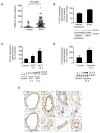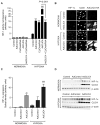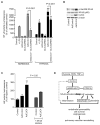Aberrant chloride intracellular channel 4 expression contributes to endothelial dysfunction in pulmonary arterial hypertension
- PMID: 24503951
- PMCID: PMC4033409
- DOI: 10.1161/CIRCULATIONAHA.113.006797
Aberrant chloride intracellular channel 4 expression contributes to endothelial dysfunction in pulmonary arterial hypertension
Abstract
Background: Chloride intracellular channel 4 (CLIC4) is highly expressed in the endothelium of remodeled pulmonary vessels and plexiform lesions of patients with pulmonary arterial hypertension. CLIC4 regulates vasculogenesis through endothelial tube formation. Aberrant CLIC4 expression may contribute to the vascular pathology of pulmonary arterial hypertension.
Methods and results: CLIC4 protein expression was increased in plasma and blood-derived endothelial cells from patients with idiopathic pulmonary arterial hypertension and in the pulmonary vascular endothelium of 3 rat models of pulmonary hypertension. CLIC4 gene deletion markedly attenuated the development of chronic hypoxia-induced pulmonary hypertension in mice. Adenoviral overexpression of CLIC4 in cultured human pulmonary artery endothelial cells compromised pulmonary endothelial barrier function and enhanced their survival and angiogenic capacity, whereas CLIC4 shRNA had an inhibitory effect. Similarly, inhibition of CLIC4 expression in blood-derived endothelial cells from patients with idiopathic pulmonary arterial hypertension attenuated the abnormal angiogenic behavior that characterizes these cells. The mechanism of CLIC4 effects involves p65-mediated activation of nuclear factor-κB, followed by stabilization of hypoxia-inducible factor-1α and increased downstream production of vascular endothelial growth factor and endothelin-1.
Conclusion: Increased CLIC4 expression is an early manifestation and mediator of endothelial dysfunction in pulmonary hypertension.
Keywords: angiogenesis inducing agents; endothelium; hypertension, pulmonary; hypoxia-inducible factor 1; nuclear factor-kappaB.
Conflict of interest statement
Figures








References
-
- Littler DR, Harrop SJ, Goodchild SC, Phang JM, Mynott AV, Jiang L, Valenzuela SM, Mazzanti M, Brown LJ, Breit SN, Curmi PM. The enigma of the CLIC proteins: Ion channels, redox proteins, enzymes, scaffolding proteins? FEBS Lett. 2010;584:2093–2101. - PubMed
-
- Bohman S, Matsumoto T, Suh K, Dimberg A, Jakobsson L, Yuspa S, Claesson-Welsh L. Proteomic analysis of vascular endothelial growth factor-induced endothelial cell differentiation reveals a role for chloride intracellular channel 4 (CLIC4) in tubular morphogenesis. J Biol Chem. 2005;280:42397–42404. - PubMed
-
- Abdul-Salam VB, Wharton J, Cupitt J, Berryman M, Edwards RJ, Wilkins MR. Proteomic analysis of lung tissues from patients with pulmonary arterial hypertension. Circulation. 2010;122:2058–2067. - PubMed
MeSH terms
Substances
Grants and funding
LinkOut - more resources
Full Text Sources
Other Literature Sources
Medical
Molecular Biology Databases

